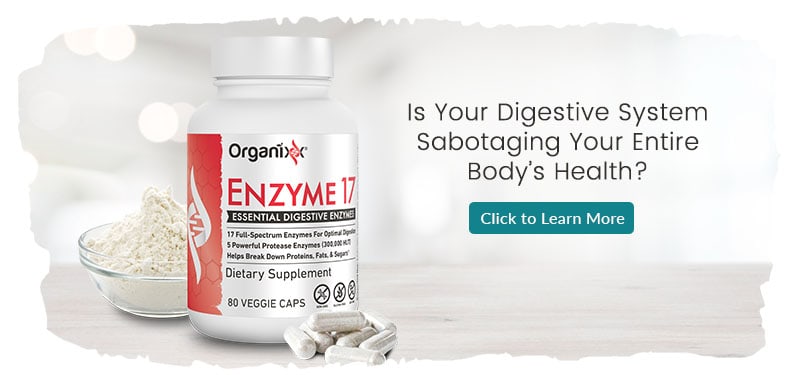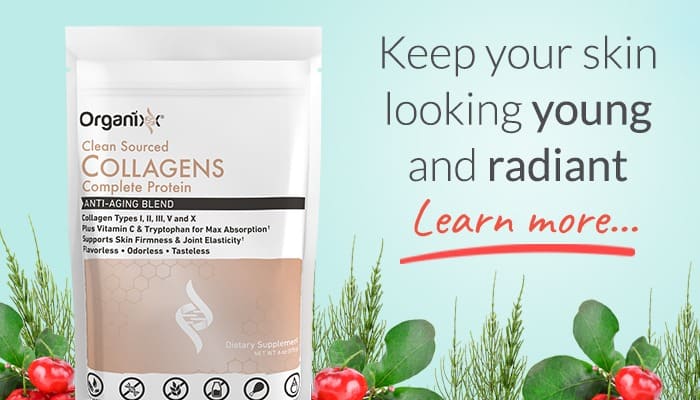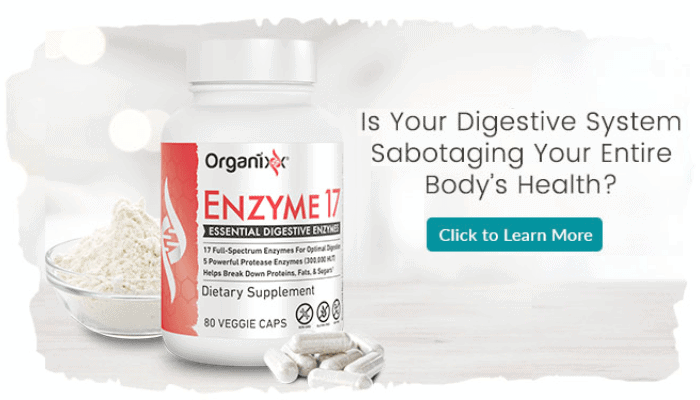The holiday season is upon us again! Although this time of year can be notoriously hard on the waistline, we here at Organixx have been working on some delicious but still nutritious recipes for you to enjoy.
These recipes were created with real, whole foods to help keep you on track with your healthy routine – without causing the sugar highs and lows of most traditional holiday fare. For even more tips on staying healthy this holiday season, be sure to check out our 27 Holiday Hacks article.
Healthy Holiday Recipes
#1. Holiday Share Wreath With Crunchy Veggies & Pumpkin Dip
For a share platter that wows and is ultra-healthy and yummy, you and your guests will love this share wreath with its delicious pumpkin dip. Make sure to include the cumin in the pumpkin dip; it has some very real health benefits, including naturally helping to lower cholesterol levels.
Vegetables:
- 8 cups broccoli florets
- 3 cups Brussels sprouts, trimmed
- 2 cups green beans, trimmed
- 1 cup sugar snap peas, strings removed
- 2 cups cauliflower florets
- 9 cherry tomatoes
- 1 bunch curly kale
- Large round or oval platter or serving board
Pumpkin Dip:
- 1 cup canned or pureed pumpkin
- 1 can black beans, rinsed
- 1/2 can cannellini beans, rinsed
- 1 scoop collagen powder
- 2 tablespoons extra virgin olive oil
- 2 cloves garlic, minced
- 2 lemons, juiced
- 1/2 teaspoon cumin
- Salt and pepper, to taste
To prepare vegetables: Rinse all vegetables well. Place a large pot of water on to boil and have a large bowl of ice water close by. Blanch broccoli for 1 or 2 minutes in the boiling water. Using a slotted spoon, transfer the broccoli to the ice bath to cool, then drain well. Blanch the Brussels sprouts, green beans, and snap peas using the same method. Let cool.
To prepare dip: Place all dip ingredients into the bowl of a food processor or blender and process until smooth. Transfer to decorative serving bowl, then place this in the center of your platter.
To assemble: Arrange the kale around the edges of the platter, placing the curly edges on the very outside edge of the platter or board. Top with broccoli florets, Brussels sprouts, green beans, snap peas, and cauliflower in the form of a wreath. Garnish with cherry tomatoes (so they look like clumps of berries). Can be refrigerated for up to 1 day prior to serving.
#2. Super Healthy Snack Crackers
These vegan, gluten-free, and grain-free crackers are easy to prepare and surprisingly tasty. So much better for you than potato chips, corn chips, or dipping breads. Serve alongside your favorite dip or salsa.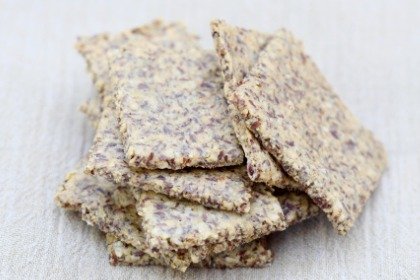
Ingredients:
- 1-3/4 cups ground flaxseed
- 1/2 teaspoon finely ground pink salt
- 1/2 teaspoon garlic powder
- 1 teaspoon Herbes de Provence
- 1/3 to 1/2 cup filtered water
Directions:
- Preheat oven to 400ºF (200ºC). Into a large bowl add all dry ingredients (including the Herbes de Provence, which are a huge part of the flavor and enjoyment of this recipe). Add the water, starting with 1/3 cup. Using a fork, mix ingredients until a smooth dough forms. If necessary, add more water. This part can also be done with a food processor.
- Place the dough between two sheets of baking parchment. Using a rolling pin, roll out the dough until it is the desired thickness of a cracker. Remove the top sheet of baking parchment and place dough (along with the bottom layer of baking parchment) onto a baking sheet. Using a sharp knife, gently cut dough into squares.
- Bake in preheated oven for 30-40 minutes, until crisp and the edges are browned (try not to let the edges go black though). When the crackers along the outside edge of the baking sheet are done, remove them from the oven and return the others to the oven until they are golden brown. Let cool, then place into an airtight container.
#3. Gluten-Free, Low-Fat Holiday Gravy
For those who wish to avoid the wheat and grease-laden traditional gravy, but still want depth of flavor, this recipe will do the trick. Vegan butter can be found at most large grocery stores and health food shops, or make your own from the recipe just below.
Ingredients:
- 1/4 cup vegan butter
- 1/2 cup onion, diced
- 1/2 cup finely chopped mushrooms (optional)
- 1/4 cup gluten-free flour (have more in reserve)
- 3 cups organic vegetable stock
- 2 tablespoons tamari sauce
- 1 tablespoon gluten-free Worcestershire sauce
- 1 teaspoon poultry seasoning, or favorite mixed herbs
- Salt and pepper to taste
- Fresh parsley
Directions:
- Into a large saucepan over medium heat, place the vegan butter and let melt. Add the onion and mushrooms (if using) and sauté until very soft and transparent (don’t rush this part, it should take about 10 minutes). Stir in your choice of flour, a small amount at a time, and it will form a thick paste coating the vegetables.
- Slowly whisk in the vegetable stock, then the tamari and Worcestershire sauces, and your choice of herbs. Whisk until smooth, raise the heat a little, and bring mixture to a low, bubbling boil.
- Reduce heat to low and simmer for 10-15 more minutes, during which time it should thicken up nicely. If it gets too thick, add a little more stock. If it is too thin, take a ladle of gravy out and put it into a small bowl, whisking in some of the reserved flour to make a smooth slurry.
- Whisk the slurry into the hot gravy, raise heat as necessary until mixture has thickened. Taste test and season with salt and pepper as needed. Garnish with fresh parsley.
#4. Vegan Butter
If you’re cutting out dairy or following a vegan eating plan, you’ll love this vegan butter recipe inspired by lovingitvegan.com that is so much healthier than margarine made with vegetable oils.
Note that you will need to remove this butter from the refrigerator a few minutes prior to spreading on fresh bread or creaming in a recipe as it will be quite solid. This should last up to two weeks in the refrigerator, and also freezes well.
Ingredients:
- 1 cup refined coconut oil, melted (do not substitute with extra virgin coconut oil)
- 2 tablespoons your choice avocado or hemp oil
- 1/3 cup unsweetened hemp milk
- 1 teaspoon apple cider vinegar
- 1 teaspoon nutritional yeast
- 1/2 teaspoon Himalayan salt
Directions:
- Into a blender container, add melted refined coconut oil along with the avocado/hemp oil, set aside.
- In a measuring cup, add apple cider vinegar and hemp milk, stir to combine. The mixture should curdle slightly. Add this to blender container. Add nutritional yeast and salt and process in a blender until quite smooth.
- Pour into a small glass dish and refrigerate until solid.
Watch a video of Katrina making the Vegan Butter recipe
#5. Simple Cranberry Cinnamon Sauce
Rather than grabbing for a jar or can of sugar-laden cranberry sauce, this year try making your own. You will still need a sweetener, but using organic maple syrup or raw honey is a healthier option and you can control the sugar level, which you can’t with pre-made cranberry sauce.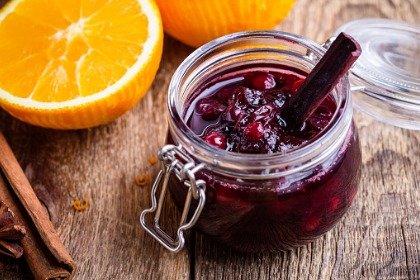
Ingredients:
- 1 pound (453 grams) fresh organic cranberries, washed
- 1/2 cup pomegranate or orange juice
- Your choice of maple syrup or raw, local honey
- Cinnamon stick (or one drop of food-grade cinnamon essential oil)
Directions:
- Into a large saucepan over med-high heat, place the rinsed cranberries, water, and cinnamon stick.
- Choose your sweetener, and start with just 1/4 cup. As mixture begins to boil and cranberries pop, taste (careful, it’s hot!) and add more of the sweetener of your choice if needed. If you choose to use cinnamon essential oil instead of a cinnamon stick, add it at the end when cranberries are cooling.
- Cranberry sauce stores well in a covered container in the fridge for a week or more, so feel free to make in advance. Place into a festive serving dish to serve.
#6. Ginger Beer Pomegranate Mocktail
This is a crowd-pleaser – tart, tangy, and full of antioxidants and gingery flavor. Yes, there’s sugar in the ginger beer or ginger ale, but it isn’t a lot and helps to offset the tart cranberries.
Despite the word “beer” in the name, ginger beer is typically non-alcoholic. Look for a brand that uses the fewest ingredients (i.e. additives) possible.
Ingredients:
- 1 tray of ice cubes
- 1 cup (250 ml) cranberry juice (with no added sugar)
- 2 cups (500 ml) pomegranate juice (with no added sugar)
- 3 cups (750 ml) ginger beer (or ginger ale if you cannot find ginger beer)
- Thin slices of fresh ginger root (peeled)
- Juice from 1 lime
- Fresh pomegranate seeds and mint leaves for garnish
Directions:
- In a large 8-cup glass pitcher, add a tray of ice cubes, then add the two juices and the ginger beer/ale and thinly sliced fresh ginger root. Stir together.
- Pour into glasses, squeeze in a little lime juice, and garnish with mint leaves and fresh pomegranate seeds.
Watch a video of Katrina making Ginger Beer Pomegranate Mocktail
#7. Baked Sweet Potatoes With Goat Cheese
Rather than succumbing to the usual sweet potato dish swamped in marshmallows, try this instead. Sweet potatoes are full of beta-carotene, and other vitamins and minerals. Goat cheese is considered a healthier option than cheese made from cow’s milk because it has fewer saturated fats and less cholesterol, is rich in vitamins and minerals, and has a healthier type of casein.
Ingredients:
- 1 sweet potato for each person (do not peel)
- Organic goat cheese, crumbled
- Handful of pumpkin seeds (pepitas)
- Freshly chopped chives
- Sea salt flakes
- Butter (vegan or regular)
Directions:
- Preheat oven to 400°F (200°C). Place each sweet potato onto foil square, place a small amount of butter on top (about 1/2 teaspoon), sprinkle with sea salt flakes, then wrap each potato loosely with the foil and place on baking tray. Bake in preheated oven for 50-60 minutes, until a knife can easily be inserted right through each potato.
- Using oven mitts, remove potatoes from foil (being careful not to burn yourself) and place onto serving plate. Slit potatoes open and into the center of each one place a portion of crumbled goat cheese, pumpkin seeds, freshly chopped chives and a dollop of butter. Serve immediately.
#8. Roasted Pumpkin and Brussels Sprouts
Brussels sprouts are a Christmas classic in England, but they usually don’t make the list of favorite holiday foods in the U.S. This recipe may just change that! Roasting these vegetables until they are slightly golden really improves their flavor and texture, and they are full of antioxidants, anti-aging minerals, and vitamins.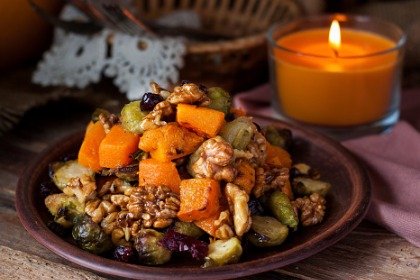
Ingredients:
- 2 tablespoons lemon-infused olive oil
- 2 cups Brussels sprouts, sliced in half
- 2 cups pumpkin, peeled and diced into 1-inch cubes
- Freshly chopped herbs of your choice (i.e. rosemary, chives, thyme, dill, oregano)
- Freshly ground pink salt and black pepper, to taste
- Toasted nuts and dried cranberries for garnish (optional)
Directions:
- Preheat oven to 425°F (210°C). Cover a large baking sheet with baking parchment paper. In a large bowl combine the Brussels sprouts, pumpkin cubes, fresh herbs, olive oil, salt and pepper. Arrange vegetables onto a baking sheet in a single layer.
- Bake in preheated oven for 40 minutes, or until the vegetables are tender when tested with a fork. Remove from oven and serve immediately.
#9. Mix-and-Match Holiday Fruit Crumble
A nice change from sugar- and wheat-laden holiday desserts, fruit crumbles are healthy(ish), delicious, and still retain much of their vitamins and minerals, even though baked.
Ingredients:
Choose from any one of these to make 6 cups of fruit or create your own unique combination:
- 5 cups thinly sliced apples + 1 cup fresh/frozen cranberries
- 3 cups thinly sliced apples + 3 cups fresh/frozen mixed berries
- 3 cups thinly sliced apples + 3 cups fresh/frozen thinly sliced rhubarb
- 3 cups fresh/frozen strawberries + 3 cups thinly sliced pears
- 3 cups thinly sliced peaches + 3 cups fresh/frozen strawberries
- 2 cups blueberries + 2 cups strawberries + 2 cups raspberries
In addition to your chosen fruit combination, you’ll need:
- 1 tablespoon arrowroot starch
- 1 cup brown rice flour
- 1 cup gluten-free rolled oats
- 1/2 cup chopped almonds, walnuts, or pecans (optional)
- 2/3 cup raw honey
- 1/3 cup coconut oil (warmed slightly if solid)
- 1 teaspoon cinnamon
- 1/2 teaspoon allspice or cloves
Directions:
- Preheat oven to 350°F (180°C). In large glass baking dish greased with coconut oil, combine the fruit and arrowroot starch.
- In a separate bowl, combine rice flour, oats, nuts, raw honey, coconut oil, and spices. Mix together until slightly crumbly. Sprinkle evenly over fruit mixture.
- Bake in preheated oven for 45-55 minutes, or until toasted and golden brown. Cool slightly and serve while warm and fragrant. (It also tastes delicious cold!)
#10. Dairy-Free Pumpkin Pie
While pie is rarely considered “healthy,” this is an old favorite made healthier and is a good choice for people who have given up dairy. The others won’t even notice the dairy is missing. The coconut milk will not impart a coconut flavor; it will be a rich and delicious pumpkin spice flavor.
Ingredients:
- 3 eggs
- 1 can (15 oz/425 gm) can organic pumpkin puree (or 2 cups fresh pumpkin puree, strained over fine mesh strainer to remove excess liquid)
- 1 cup full-fat coconut milk
- 1 teaspoon vanilla extract
- 3/4 cup dark brown sugar
- 1/2 teaspoon sea salt
- 1 teaspoon ground cinnamon
- 1/2 teaspoon clove
- 1/2 tsp nutmeg
- Pre-made pie crust of your choice, unbaked
Directions:
- Preheat oven to 425°F (210°C). In a large bowl, beat the eggs until creamy. Add in pumpkin puree, coconut milk, and vanilla extract; beat until well combined. Add sugar, salt, and spices and beat until completely combined.
- Into a dish containing the pie crust, pour the pumpkin filling over the crust. Cover the crust with foil or pastry shield to prevent burning. Bake pie for 15 minutes. Reduce oven temperature to 350°F (180°C) and continue to bake for 50 to 60 minutes, or until a knife inserted into the center comes out clean. The filling may still be a little wiggly in the center, but it will firm up as it cools.
- Allow pie to cool on a wire rack for two hours (remember not to rush this). Serve or refrigerate until ready to serve.
#11. Peppermint Fudge No-Bake Energy Bites
Is mint chocolate your guilty pleasure? Try these no-bake energy bites that are full of delicious and healthy ingredients… with nothing to feel guilty about.
Ingredients:
- 1/2 cup raw almonds
- 1/3 cup pitted dates (about 6 or 7)
- 1 tablespoon Organixx Clean Sourced Collagens powder
- 1 tablespoon organic cacao powder
- 3/4 teaspoon pure vanilla extract
- 1 drop peppermint essential oil
- 1 tablespoon coconut oil
- 1 tablespoon miniature dark chocolate chips
- Optional outer covering: cacao powder, toasted coconut, toasted chopped nuts
Directions:
- Into the container of a food processor, place almonds and process until finely chopped. Add dates and process until smooth. Add collagen and cacao powder, vanilla extract, peppermint oil, and coconut oil. Process for several minutes, until mixture begins to look well combined. Add a teaspoon of water, if necessary, to help it all combine. Add chocolate chips and pulse a few final times to combine well, making sure not to completely pulverize the chocolate chips; you want them chunky still.
- To roll into balls, take a heaping teaspoon of the mixture in your hands and roll it into a ball. The coconut oil will soften and it may be a little messy but it helps to bind these together. Place your choice of outer toppings (cacao powder, toasted coconut, or toasted chopped nuts) into a bowl and roll each bite through this.
- Place balls onto serving plate or container and refrigerate for 30 minutes prior to serving to solidify the coconut oil. Enjoy!
Watch a video of Katrina making the Peppermint Fudge No-Bake Energy Bites
We here at Organixx wish you and your family a safe and happy holiday season, filled with the people you love… and lots of healthy, delicious foods. Want more healthy recipes? Click here to check out our recipe page.
Organixx Clean Sourced Collagens blend contains five types of collagen from four sources. What’s more, it’s combined with targeted nutrients such as zinc, vitamin C, and vitamin B6 which specifically enhance the bioavailability and potency of collagen. Clean Sourced Collagens is formulated from the ground up to enhance and support your body’s natural ability to heal and rebuild itself from the INSIDE out.
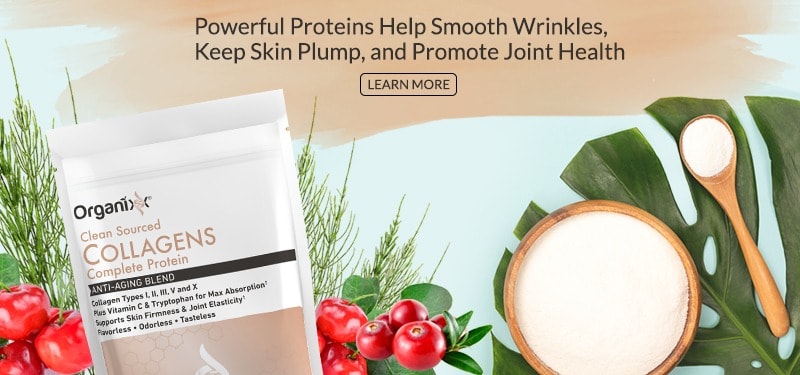
Chances are, you’ve never heard of dong quai before – yet it’s a very popular health product in China, Japan, and Korea.
Pronounced as dang gui in Chinese, the name literally means “restore proper order.” A member of the same family as carrots, celery, parsley, and coriander, dong quai is a traditional medicinal and edible plant, typically harvested for its leaves and roots. The roots are usually dried and cut up into pieces or ground into powder for brewing into an herbal tea with a strong, bitter taste similar to anise (the distinctive flavor of licorice).
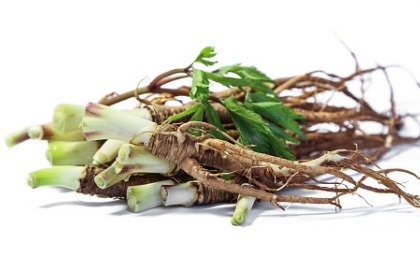
Also known as Chinese angelica (scientific name Angelica sinensis), the “Empress of herbs,” and female ginseng, dong quai has long been used in traditional Chinese medicine (TCM) for toning, replenishing, and invigorating blood as well as relieving pain, combating constipation, and treating irregular menstruation and amenorrhea [1].
It is believed that dong quai’s health-promoting properties are because of the naturally occurring compound coumarin, along with others, such as ferulic acid and phytosterols.
Dong Quai in Traditional Chinese Medicine (TCM)
The biological actions of dong quai have been extensively researched for thousands of years in China, where it has a well-established reputation as a remedy for ailments of the female reproductive system and as a blood tonic.
Research from China indicates that dong quai boosts production of red blood cells, promotes better blood circulation, and dissolves blood clots. Chinese herbalists typically prescribe this herb to women who need to enrich the quality of their blood throughout the menstrual cycle, during and after childbirth, and during the transition to menopause.
For women in menopause, it is prescribed to reduce the severity of hot flashes, insomnia, and mood changes. This is why dong quai is known as the “female ginseng.”
Additionally, dong quai has been shown to contain high levels of vitamin A, C, B3, B12, and E, along with the minerals iron, cobalt, magnesium, and potassium. For this reason, this medicinal herb is routinely prescribed as a tonic, usually in combination with other Chinese herbs, to treat fatigue, mild anemia, high blood pressure, and poor circulation in both men and women.
Dong Quai Relieves Symptoms of Menopause
Menopause is a natural reduction in the number of female hormones produced by the ovaries, especially estrogen, typically as women get into their 40s and 50s. Symptoms of this decline include hot flashes, night sweats, hair loss, changes in mood, and loss of bone strength and density, known as osteoporosis.
An Alternative to HRT?
Many women turn to hormone replacement therapy (HRT) which provides synthetic hormones to combat the effects of menopause – however, these come with their health risks and adverse effects.
As we have already seen, dong quai has a long history in TCM as a natural resource to help alleviate symptoms of menopause.  Modern scientific research supports this therapeutic function of dong quai.
Modern scientific research supports this therapeutic function of dong quai.
For example, in a 2003 study, 55 postmenopausal women complaining of hot flushes were randomly assigned to either chew five tablets daily of dong quai and chamomile or placebo tablets for 12 weeks [2]. For the entire duration of the study, these women were asked to complete a daily questionnaire that assessed the frequency and intensity of their menopausal symptoms.
Relative to women in the control group, women who took dong quai and chamomile experienced a dramatic reduction in both the number and intensity of hot flashes in the first month already, and reported fewer sleep disturbances and less fatigue.
The authors of the study concluded that dong quai helps to relieve the symptoms of menopause without any apparent major side effects and that it can be considered as a natural alternative to HRT [2].
Similarly, a randomized, crossover study published in 2016 showed that a combination of nutraceuticals – which contained a dry extract of dong quai – given to 43 postmenopausal women for four weeks helped to relieve their symptoms, while also improving their cardiovascular profile [3].
The results of these and other studies are not surprising, given that extracts of dong quai roots have been shown to have estrogenic activity in laboratory animal experiments [4].
Can Dong Quai Help Reverse Bone Loss (Osteoporosis)?
Osteoporosis is a bone disease. The word comes from the Latin for “porous bones.”
Healthy bones have small spaces inside them, like a honeycomb. These spaces tend to grow larger during osteoporosis so that bones lose both their strength and density.
Osteoporosis is quite common in older adults, especially in women when they reach menopause. Unfortunately, osteoporosis increases the risk of fractures – especially in the ribs, hips, and bones in the wrists and spine – even when carrying out routine activities such as standing or walking.
In China, dong quai is believed to help prevent bone loss and even to help build bone strength. Indeed, preliminary laboratory studies in cell lines and animals seem to confirm this, although there have been no human clinical trials confirming these results so far.
In a 2016 study, a natural compound known as ferulic acid, extracted from dong quai roots, was shown to boost bone mineral density, bone mineral content, and trigger bone cell growth in laboratory mice [5].
Similarly, treating rats with dong quai extract was seen to help preserve bone mineral density [6]. Even better, a dong quai extract was shown to trigger collagen synthesis and stimulate the growth of human bone precursor cells in a laboratory experiment [7].
Dong Quai Promotes Heart Health
 Heart disease is the leading cause of death in the U.S. today. Improving cardiovascular profile – specifically, reducing the ratio of total cholesterol to low-density lipoprotein (LDL) as well as the ratio of LDL to high-density lipoprotein or HDL, along with lowering levels of triglycerides are all considered effective ways to reduce heart disease risk.
Heart disease is the leading cause of death in the U.S. today. Improving cardiovascular profile – specifically, reducing the ratio of total cholesterol to low-density lipoprotein (LDL) as well as the ratio of LDL to high-density lipoprotein or HDL, along with lowering levels of triglycerides are all considered effective ways to reduce heart disease risk.
Promisingly, a 2015 laboratory study has shown that treating mice with dong quai for four weeks lowered levels of both total cholesterol and triglycerides. Dong Quai was also seen to lower levels of fasting blood glucose and serum insulin, thereby reducing diabetes risk [8].
Similarly, combining dong quai with Huang qi, another medicinal plant, was seen to reduce levels of total cholesterol, triglycerides, LDL, and very low-density lipoprotein (VLDL) in a laboratory experiment on rats [9].
In a very promising outcome from a study in China back in 1992, treatment with dong quai lowered blood pressure and improved heart function in 40 patients with chronic obstructive pulmonary disease (COPD) [10].
When Not to Take Dong Quai
Dong Quai consumption has been associated with some side effects, including the sensitivity of the eyes and skin to light, excessive development of breasts in men (gynecomastia), diarrhea, and fever – hence, it should only be taken medicinally under the supervision of a qualified herbal practitioner.
Further, it is advisable not to take dong quai in any form when:
- taking anticoagulants such as warfarin, as dong quai contains coumarin, which promotes blood thinning, and may increase the risk of bleeding
- pregnant or breastfeeding
- undergoing radiation therapy, as dong quai can worsen the effects of radiation therapy on the skin
- having hormone-sensitive cancer, as dong quai has estrogenic effects and can potentially stimulate the growth of estrogen-responsive cancer cells [11]
Pregnant or lactating women and menstruating women who are experiencing unusually heavy bleeding, in particular, should not use dong quai unless advised by a qualified healthcare practitioner.
Organixx Clean Sourced Collagens blend contains five types of collagen from four sources. What’s more, it’s combined with targeted nutrients such as zinc, vitamin C, and vitamin B6 which specifically enhance the bioavailability and potency of collagen. Clean Sourced Collagens is formulated from the ground up to enhance and support your body’s natural ability to heal and rebuild itself from the INSIDE out.

Menopause (the ceasing of menstruation and reproduction) is a normal change that a woman will go through on average between the ages of 50 and 55 – although it can happen much earlier. Understanding the changes that happen in the body is vital, as natural decline in hormone levels during menopause can significantly affect a woman’s health for years to come.
The menopause process is gradual and has a few stages along the way. It starts as perimenopause, during which time the ovaries begin to make less of the hormones estrogen and progesterone, which interferes with an egg being consistently released each month. (By the way, the term menopause actually refers to when a woman has been 12 consecutive months without a period or other signs of fertility. Postmenopause is the stage after menopause has occurred. However many people use the term “menopause” to describe the entire process.)
The decline of hormone production starts slow (typically around age 35) and speeds up through her 40s as a woman approaches actual menopause. At some point during this transition, the ovaries get smaller and stop producing estrogen and progesterone altogether. At this stage, the adrenals take over the job of producing the sex hormones and menopause symptoms often become more pronounced.
The Problem With Diminishing Progesterone
The adrenal glands are widely known for the production of the stress hormones cortisol and adrenaline. But what many people 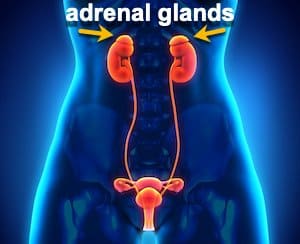 don’t realize is that the adrenals also produce other hormones, including the sex hormones estrogen and progesterone.
don’t realize is that the adrenals also produce other hormones, including the sex hormones estrogen and progesterone.
The adrenal glands are part of your long-term, back-up hormonal replacement part system and are designed to release whatever female hormone you may need. However, if the adrenals are not functioning well, sufficient progesterone won’t be produced which can cause havoc in the body.
The main purpose of progesterone is to prepare the body for pregnancy and provide the necessary support to ensure the fetus is carried to term. However, that is not the only role that progesterone plays in a woman’s body.
Progesterone is responsible for many important tasks, such as:
- increasing libido
- protecting against fibrocystic breast disease
- maintaining the uterine lining
- hydrating and oxygenating the skin
- decreasing hair thinning
- acting as a natural diuretic
- helping protect against depression and increasing a sense of well-being
- encouraging fat burning and the use of stored energy
- improving clarity
- promoting good sleep
Other Hormones Also Need Progesterone
Progesterone is also the precursors for other important stress and sex hormones (which means it’s needed to make other hormones). While estrogen levels don’t fall until later in the menopause transition, progesterone levels decline sooner and more dramatically leading up to menopause.
Body signals that include symptoms such as hot flashes are most likely the result in a shift in the balance between estrogen and progesterone.

The Impact of Stress on Progesterone
Another risk to progesterone is that the body releases cortisol in response to physical and psychological stress.
When we experience periods of stress, our bodies excrete cortisol to help us work through whatever the situation may be. If there’s a high demand for cortisol due to prolonged stress and the body is unable to keep up with the supply, it will take from cortisol’s pre-hormone, pregnenolone (the mother hormone of all sex hormones).
When more of pregnenolone is used to make cortisol, less will be available to make progesterone, which will further exacerbate menopausal symptoms and affect overall well-being.
The short-term results of stress may not be noticeable, but in the long run chronic stress can lead to adrenal fatigue. This sets the stage for increased inflammation in the body and lowered immunity, which creates numerous disease states.
Are YOU Suffering From Adrenal Exhaustion?
If you have been under constant stress for a prolonged period of time, you may be at the point where your adrenals are fatigued and your hormones are significantly out of balance.
Noticeable symptoms, such as weight gain, irritability, racing thoughts, chronic fatigue, and sleep disturbance are common in people who have adrenal fatigue. When adrenal fatigue is the primary cause of your low progesterone level, you need to focus on rebuilding your adrenal foundation.
Do you find yourself constantly fatigued and struggling to get out of bed in the morning? Do you feel unable to cope with stressful situations? If so, you might be suffering from Adrenal Fatigue Syndrome.
Answer These 18 Yes or No Questions
The more “yes” answers you have to the following questions, the more likely you are to have exhausted your adrenals:
- Do you have difficulty getting up in the morning?
- Do you have continued fatigue or low energy?
- Are your thoughts less focused; do you have brain fog?
- Do you have difficulty falling asleep or staying asleep?
- Do you crave salty, fatty, or sweet foods?
- Do you have blood sugars issues (hyperglycemia or hypoglycemia)?
- Do you have an afternoon slump between the hours of 2 and 5 pm?
- Do you often have muscle aches or pains for no apparent reason?
- Do you have an increased sense of irritability?
- Do you feel overwhelmed by all that needs to be done?
- Have you noticed an increase in belly fat and an inability to get rid of it?
- Do you have a decreased sex drive?
- Do you have low blood pressure?
- Do you have a low body temperature or feel cold all of the time?
- Do you have an increase in mood swings and or depression? Lack of enthusiasm?
- Do you experience dizziness when getting up quickly from a lying or sitting position?
- Do you suffer from increased allergies even if you have never had allergies before? Do you have food allergies?
- Do you have increased menopausal symptoms?
If you suspect you have adrenal fatigue, here are 6 ways you can do an adrenal fatigue test at home (and also consult with your healthcare provider!)
How to Support Your Adrenal Glands
The adrenal glands, just like the other glands in your body, need quality food to do their job effectively. It’s important to consume a clean diet loaded with organic fruits and vegetables that is devoid of artificial sweeteners and processed foods.
a clean diet loaded with organic fruits and vegetables that is devoid of artificial sweeteners and processed foods.
Daily detoxification is also essential. Cruciferous vegetables such as kale, broccoli, and cauliflower help detoxify the body.
Milk thistle can be helpful as it helps to break down and eliminate excess hormones and toxins. Be sure to drink plenty of water from a pure source. Your liver has to process any unused chemicals – the more toxins you put in your body, the harder the organs of detoxification have to work.
Stress reduction is also important as research shows that stress and anger are significant factors in menopausal symptoms and contribute to adrenal fatigue. Many women find they have more hot flashes and other symptoms when the adrenal glands are overworked by stress.
Electric and magnetic fields (EMFs) emitted from electronic devices (including your cell phone!) stimulate the body’s stress system, decreasing the ability to wind down and fall asleep. Once you finally do fall asleep, EMFs interfere with the deep sleep your body needs. Poor sleep also causes the adrenals to pump more cortisol, which keeps you awake longer and causes you to wake up after you fall asleep.
The bottom line is that women are systemically being told that their hormone levels are “within range,” but this is far from the truth. Further investigation with a healthcare professional fluent in hormonal issues is often required.
Feeding the adrenals, reducing your toxic load, supporting the liver, and addressing adrenal fatigue can help balance the hormones, which can actually make women healthier, happier, and more balanced during all phases of the menopause process.
13 Tips for Reducing Adrenal Fatigue
- Get 7-8 hours sleep every night.
- Heal the gut with probiotics and bone broth.
- Optimize liver function and detoxification with milk thistle and cruciferous vegetables.
- Get enough B5, also known as pantothenic acid, as it helps provide the extra energy your adrenal glands need to respond to stress and helps repair previous damage to these glands.
- Herbs such as Holy basil help to inhibit the release of cortisol and balance blood sugar levels.
- Reishi mushroom can help resolve the hormonal imbalance.
- Ashwagandha helps alleviate brain fog and memory problems associated with chronic stress and bring a sense of calm to the body.
- Walk briskly or engage in another exercise 4-7 hours per week, with a balance of cardio and strength training. (Go here to discover more about the Best Exercises for Women Over 50)
- Give yourself “me time” for at least one hour a day, which can include stress-relieving activities such as QiGong and Yoga Nidra, or simply taking a walk in nature.
- Consume a healthy diet including adrenal-supportive omega 3-rich foods.
- Keep a gratitude journal.
- Limit cell phone and computer use in the evening hours.
- Enjoy life, laugh more, and find joy in every day.
While the cessation of the menstrual cycle may be an inevitable transition all women go through, supporting your adrenal glands as early as you can in the process will have a huge impact on how you look and feel through menopause and beyond.
Organixx Clean Sourced Collagens blend contains five types of collagen from four sources. What’s more, it’s combined with targeted nutrients such as zinc, vitamin C, and vitamin B6 which specifically enhance the bioavailability and potency of collagen. Clean Sourced Collagens is formulated from the ground up to enhance and support your body’s natural ability to heal and rebuild itself from the INSIDE out.

Menopause, often referred to as “the change of life,” is something that all women will go through at some point. It’s the winding down of a woman’s fertile years and has no clear start or end point for most women. In perimenopause – the years leading up to actual menopause (which is 12 consecutive months without a period) – many women will begin to experience a host of symptoms as their hormone levels begin to fluctuate and eventually drop.
While mood swings and hot flashes are hallmarks of menopause, there are actually many signs and symptoms that women (and the men who care about them) need to be aware of. These can be both emotional and physical, and range from mild to severe.
Read on for 16 of the most common signs and symptoms of menopause and helpful tips for dealing with them. By the way, a “symptom” is something that you feel or experience. A “sign” is something someone else can detect in you. When it comes to hot flashes and mood swings, they are often both signs and symptoms!
16 Common Signs & Symptoms of Menopause
#1. Hot Flashes and Night Sweats
Hot flashes are a sudden sensation of warmth spreading through the body, particularly on the face and neck. They are typically brought on by declining estrogen levels. Night sweats are also caused by hormonal imbalance and can disrupt sleep.
Many women find that raising progesterone levels can alleviate these problems. Magnesium, zinc, and vitamins B6, C, and E  support the production of progesterone.
support the production of progesterone.
Ashwagandha, a powerful adaptogen, maca, licorice root, and other herbs are also known to boost low progesterone levels. You may also want to dress in layers during the day and sleep in a cold room with plenty of blankets you can kick off when needed.
#2. Mood Swings
Mood swings are due to hormonal changes as low levels of estrogen can cause irregularities in the brain. Estrogen increases serotonin, a chemical in the brain that boosts mood. As estrogen levels decline (and subsequently serotonin) one may feel less happy.
Relief can often be as easy as engaging in moderate exercise, spending time in nature, and engaging in deep breathing exercises – all of which promote a sense of calm and improve mood.
#3. Sugar Cravings
When hormones are out of balance cortisol levels to rise, which increases sugar cravings. High cortisol contributes to adrenal fatigue, which actually predisposes you to those cravings.
Ashwagandha supports adrenal function by reducing stress and lowering cortisol levels. Maca root also supports the adrenals. Holy Basil has been found to help balance cortisol, reduce cravings, and manage weight. Sleep deprivation will exacerbate cravings, so don’t skimp on the hours of rest you’re getting.
#4. Insomnia
The inability to sleep or stay asleep is one of the most annoying symptoms of menopause. Once again, hormonal imbalance is often to blame. Maintaining a consistent sleep schedule can help. Meditation and relaxing yoga can aid in clearing the mind for more restful sleep.
#5. Brain Fog, Memory Lapses, and Difficulty Concentrating
Feeling confused, forgetful, and/or finding yourself with a lack of focus and mental clarity? Once again, declining estrogen is to blame.
Drink more water and be sure your body is well-nourished. Concentrate on healthy sources of fats such as avocados, olive oil, oily fish, and seeds, which are needed for healthy hormone production.
#6. Anxiety &Depression
Depression and anxiety and can be due to unresolved childhood trauma. Consider working with a therapist to get to the source of the problem.
Before you resort to drug therapy, know that hormone imbalance can also be involved. When hormones shift and become out of balance, the result can be increased depression and anxiety.

#7. Weight Gain and Redistribution
The hormonal changes of menopause may make you more likely to gain weight around your abdomen than around your hips and thighs.
Menopause weight gain isn’t inevitable, however. You can reverse course by paying attention to healthy-eating habits and leading an active lifestyle, which can help revitalize the body’s metabolic rate.
Endocrine disruptors such as plastics and other chemicals mimic natural hormones and significantly contribute to weight gain. Ditch the plastic in your kitchen and use utensils and storage containers made from wood, glass, stainless steel, and natural materials.
A diet rich in cruciferous vegetables can help the body detoxify and flush out harmful chemicals. Milk thistle promotes liver health and regeneration which in turn helps the body to break down excess hormones, metabolize fat, and expel toxins from the body.
#8. Fatigue
Fatigue can be the result of hormone fluctuation, particularly declining estrogen. Supportive nutrition and restful sleep can help. Compounds in reishi mushroom may help decrease fatigue and help resolve the overall hormonal imbalance.
#9. Water Retention and Puffiness
Puffy feet, hands, and belly are often the results of the natural decline of estrogen and progesterone. Lemon water and roasted dandelion tea are natural diuretics. As counterintuitive as it might sound, drinking plenty of water throughout the day can help reduce bloat.
#10. Low Libido and Vaginal Dryness
Loss of libido can be caused by hormonal imbalance or by other symptoms of menopause such as vaginal dryness or depression. Vaginal dryness occurs when the moistness in the lining of the vagina disappears. When estrogen levels drop during menopause it causes a lack of lubrication.
The adaptogenic herb ashwagandha improves vaginal lubrication and encourages a calm and relaxed feeling. Non-toxic products such as coconut oil or over-the-counter non-toxic lubricants can also make sex more comfortable and enjoyable.
#11. Urinary Tract Infections (UTIs)
UTIs can often result from declining estrogen levels and changes in the urinary tract that make you more sensitive to infection. Immune-boosting foods, herbs, and supplements such as medicinal mushrooms, zinc, and vitamin D can be helpful. Be sure to drink plenty of pure water to help flush out bacteria.
#12. Hair Loss or Thinning Hair
Thinning hair is often caused by estrogen deficiency because hair follicles need estrogen to grow and stay healthy. Hair is also made from protein, which is why increasing your intake of collagen can be beneficial in maintaining thick, healthy hair.
#13. Headaches
Headaches during menopause are also linked to hormonal imbalance. As estrogen drops, headaches can become more frequent and may worsen. Turn to natural solutions when possible such as specific essential oils which can help with headache pain relief.
#14. Itchy Skin
Itchy skin is one of the first symptoms of menopause because collagen loss is most rapid at the beginning of menopause.  As estrogen levels drop, collagen production slows down. Supporting your body with collagen through consuming adequate protein and/or supplementation may be helpful.
As estrogen levels drop, collagen production slows down. Supporting your body with collagen through consuming adequate protein and/or supplementation may be helpful.
Amla berry is also known to promote healthy skin and to support the hormonal system.
#15. Osteoporosis and Bone Loss
Osteporosis and bone loss result from declining estrogen. Support bone density with low impact exercise (including strength training) and eating more green leafy vegetables such as spinach and kale. Vitamin K2 will help direct calcium out of joints and arteries and into the bones where it belongs.
#16. Irregular Heartbeat
An irregular heartbeat can be triggered by a decline in estrogen as this will over-stimulate the nervous and circulatory systems. This can cause irregular heartbeat, palpitations, and arrhythmias and can increase the risk of heart disease and high blood pressure.
A healthy lifestyle (including diet, exercise, and minimizing stress) that supports good heart health is your best bet.
Eating Well Matters Even More in Menopause
As you’ve seen repeatedly in the tips above, proper nutrition is one of the best strategies to minimize the symptoms of menopause and any negative impact they can have on the body.
A healthy diet will help balance your hormones, which in turn will support the adrenal glands which are responsible for producing your hormones once your ovaries stop.
Maintain a proper balance of protein, fat, and healthy carbohydrates. Eating 10-15 servings of vegetables daily (especially cruciferous vegetables such as broccoli, kale, and cauliflower) will help detoxify harmful chemical estrogens that can exacerbate menopause symptoms. It’s also highly beneficial to engage in moderate exercise and activities that help reduce stress, such as yoga, walking in nature, and meditation.
Organixx Clean Sourced Collagens blend contains five types of collagen from four sources. What’s more, it’s combined with targeted nutrients such as zinc, vitamin C, and vitamin B6 which specifically enhance the bioavailability and potency of collagen. Clean Sourced Collagens is formulated from the ground up to enhance and support your body’s natural ability to heal and rebuild itself from the INSIDE out.

One might argue that one of the most amazing feats of human engineering is the automobile. Consider everything that goes into making one… from the advanced assembly lines to the precise robotics, to the human ingenuity behind it all. Those human beings were able to come up with a way to harness energy from the earth and basically infuse it into a boxy metallic structure on wheels that can take us wherever we desire is nothing short of awe-inspiring when you really stop and think about it.
As incredible as they are, though, cars would be entirely worthless if not for the human brainpower behind their build and daily operation. What makes a car a useful machine, in other words, are the regular refuelings, oil changes, tire rotations, and maintenance that keep it running smoothly – all  things that are entirely impossible without human involvement, willingness, and know-how into what it takes to keep a car going.
things that are entirely impossible without human involvement, willingness, and know-how into what it takes to keep a car going.
Where we’re going with all of this is that the human body functions similarly to a car in that it’s a finely-tuned creation that requires its own special inputs for proper function and maintenance.
Our bodies are obviously much more impressive “machines,” in that they’re uniquely equipped to perform self-maintenance and self-regenerate without the need for a driver. At the same time, they still require outside help – primarily in the form of proper nutrition − in order to thrive.
Why Your Body Needs Enzymes
But what is proper nutrition, and more importantly, how is your body able to benefit from it? Every time you eat, your body produces saliva, bile, and other digestive catalysts that break down the foods and converts them into smaller molecules.
These molecules are used to build muscle tissue, regenerate cells, strengthen immunity, and produce energy. Proteins, carbohydrates, vitamins, and minerals all get broken down during this process in order to fuel your body.
Going back to our car analogy… if our physical bodies are like the raw materials from which a car is made, and the food is our fuel, then digestive catalysts are the drivers that make sure our bodies are operating as they should and are properly maintained at all times.
Among the most important of these catalysts are enzymes, the biochemical catalysts found in food and inside our bodies that facilitate the necessary chemical reactions needed to keep the whole process going as normal.
“Enzymes are substances that make life possible,” says Dr. Edward Howell, MD, pioneer of Enzyme Therapy and author of Enzyme Nutrition: The Food Enzyme Concept.
“They are needed for every chemical reaction that takes place in the human body. No mineral, vitamin, or hormone can do any work without enzymes. They are the manual workers that build our body from proteins, carbohydrates, and fats, just as construction workers build our homes. You may have all the raw materials with which to build, but without the workers (enzymes) you cannot even begin.”
Symptoms of Enzyme Deficiency
Enzymes are obviously very important for life, so where you one find them? Raw foods naturally contain enzymes, which act as digestive co-factors every time you eat. Your body also makes some of its own enzymes, though it primarily relies on enzymes in food to digest and assimilate nutrients.
 When these enzymes are lacking as a result of cooking, pasteurization, or some other form of processing, then the body has to work overtime to make up for it.
When these enzymes are lacking as a result of cooking, pasteurization, or some other form of processing, then the body has to work overtime to make up for it.
This is a taxing process that, over time, can leave the body enzyme-deficient. Some of the more common symptoms of enzyme deficiency include:
- indigestion
- acid reflux
- bloating after eating a meal
If you feel like food is just taking its sweet time moving through your system, or if you feel constipated or experience irregular bowel movements on a regular basis, you could be lacking in enzymes, and thus your body is incapable of fully digesting your food in a timely manner.
Other signs of an enzyme deficiency can include:
- lack of energy
- brain “fog”
- muscle degradation
- weakness
- joint pain
- difficulty sleeping due to an upset stomach
When your body isn’t able to extract the nutrients it needs from food, then it can’t provide you with energy or vitality, nor can it effectively engage in any of the reparation processes by which your body stays healthy and in tip-top shape.
Which Enzymes Do You Need?
So what types of enzymes does your body need, and where can you find them? Let’s start with the basics:
-
Metabolic Enzymes
Metabolic enzymes are necessary for the proper function of every system of the body – including every tissue, cell, and organ. Metabolic enzymes facilitate both the production of energy and detoxification within the body’s 100 trillion-plus cells, and they’re manufactured by the body for this purpose.
-
Digestive Enzymes
Digestive enzymes are secreted within the digestive tract to help break down food and extract nutrients. Examples of digestive enzymes include pepsin, trypsin, lipase, protease, and amylase. The body is capable of producing some of these itself, but it also relies upon the natural enzymes found in raw foods to help with the process.
-
Food Enzymes
Food enzymes occur naturally in food and pair perfectly with the digestive enzymes manufactured by the body. Raw foods contain only enough food enzymes for that particular food, however, which is why supplemental food enzymes are often recommended. Supplemental enzymes also offer systemic support to help clean up the blood, neutralize and eliminate toxins, and repair cell tissue.
In a perfect world, we would get all the food enzymes we need from food, and our bodies would take care of the rest. But in our imperfect world, food is often lacking in enzymes due to processing, pasteurization, and everyday cooking.
When our food is deficient in enzymes, our bodies have to make up for it. After a while, however, our bodies become depleted of enzymes, and that’s when health problems start.
Aside from eating more raw food, the best remedy for enzyme deficiency is to take enzyme supplements.
The best digestive enzyme supplements include enzymes such as:
- Amylase – breaks down carbohydrates, sugars, and starches in grains, rice, potatoes, fruits, vegetables, beans, and herbs
- Alpha Galactosidase – breaks down simple sugars (polysaccharides) and complex sugars (oligosaccharides) in legumes and cruciferous vegetables
- Beta-glucanase – breaks down cellulose (plant fiber) in grains and cereals
- Bromelain – breaks down proteins, and also provides proteolytic (systemic) support for the body
- Catalase – breaks down hydrogen peroxide into water and oxygen
- Cellulase – breaks down food fiber (cellulose) in fruits and vegetables
- Glucoamylase – breaks down long-chain carbohydrates and starches in grains and potatoes
- Hemicellulase – breaks down hemicellulose, a type of cellulose in plant walls, as well as non-cellulose polysaccharides
- Invertase – breaks down sucrose and simple sugars
- Lactase – breaks down lactose, a simple sugar found in milk and dairy products
- Lipase – breaks down fats in butter, cheese, meat, and oils
- Papain – breaks down proteins
- Pectinase – breaks down pectin, a polysaccharide found in fruits and vegetables
- Peptidase – breaks down proteins into amino acids
- Phytase – breaks down carbohydrates, as well as “anti-nutrients” like phytic acid in plants, grains, and seeds
- Protease – breaks down proteins in meat, fish, poultry, grains, nuts, gluten, and milk (casein)
- Xylanase – breaks down nutrients in high-fiber vegetables
Every single one of these food enzymes is essential for life, and chances are you’re not getting enough of them as part of your daily diet. In fact, unless you’re eating a high-quality 100 percent raw food diet all the time, you’re probably not getting enough food enzymes, which is why supplementation can be beneficial.
Not only will supplemental enzymes help you get more nutrition from the foods you eat, but your body will also get the support it needs systemically to grow healthier, stronger, and more robust.
Organixx Enzyme 17 contains a whopping FIVE kinds of powerful protease enzymes in combination with one of the most advanced enzyme blends on the planet. It’s scientifically designed to help your body break down and process nutrients for better absorption, digestion, and overall health.
